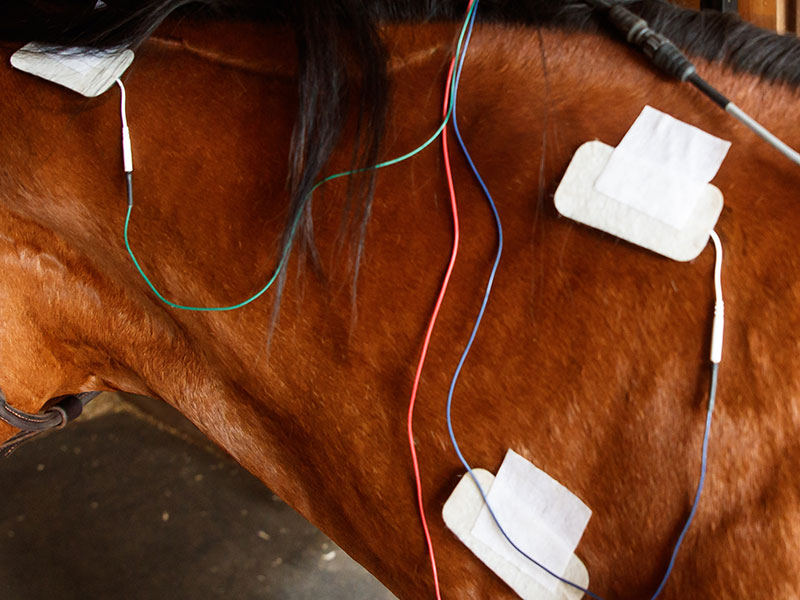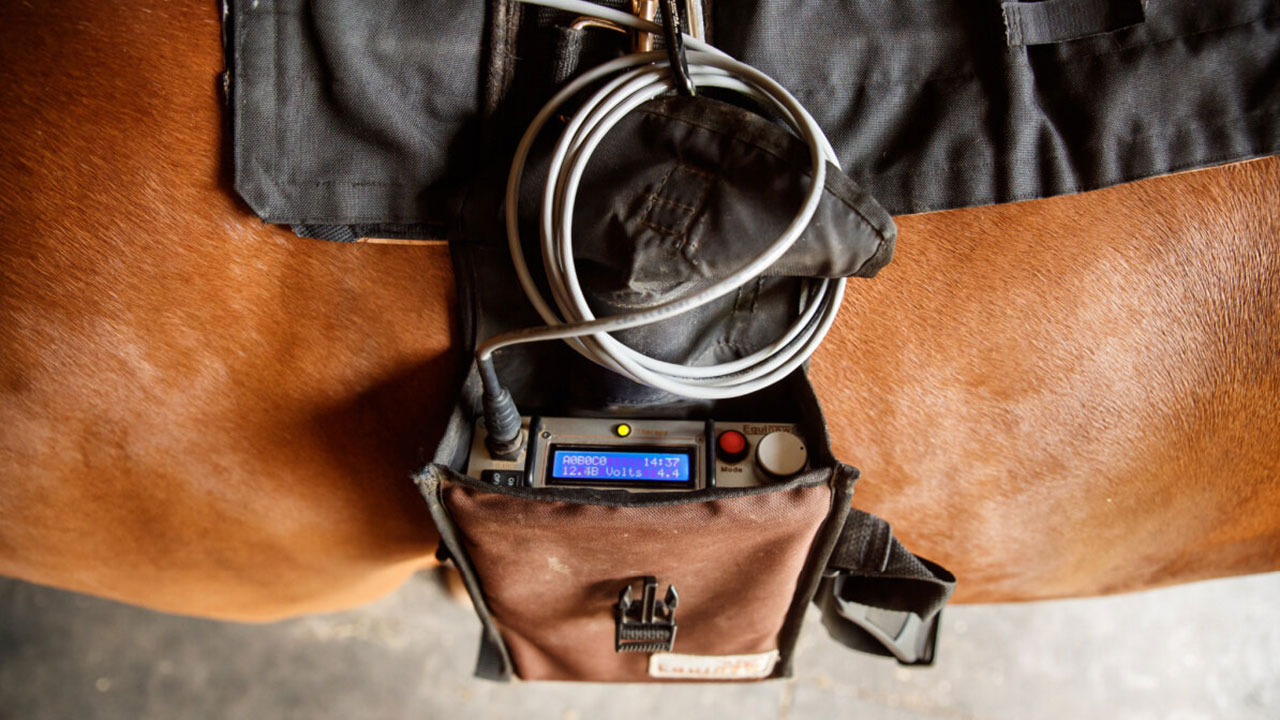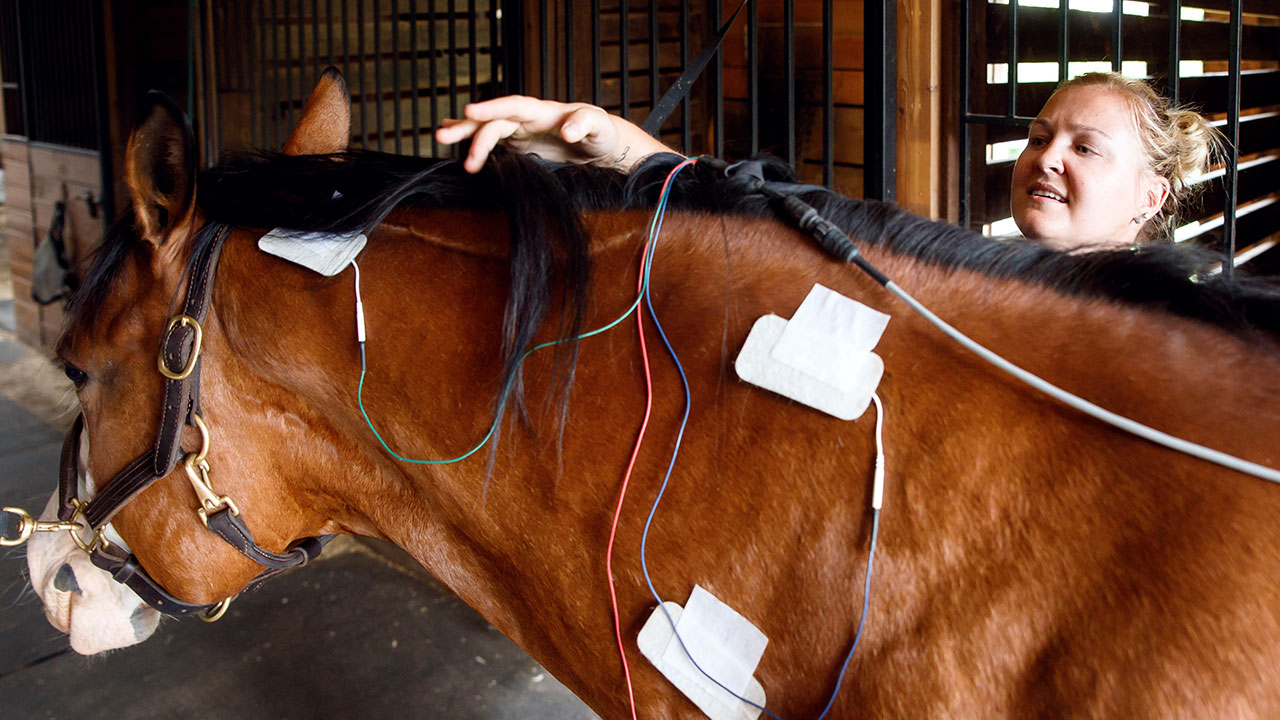Functional Electrical Stimulation
FES stimulates healthy muscle function supporting your horse during injury and keeping him performing at his best.
What FES can do for your horse
When your horse has suffered an injury, keeping him moving without causing more damage can be a challenge. FES mobilizes injured or strained tissues sending controlled electrical impulses to facilitate normal muscle movement.
FES has been shown to be effective in…
- Returning normal movement to injured tissues
- Improving tissue healing through increased circulation
- Reducing pain and inflammation
- Reversing muscle wastage
So your horse can start to rehabilitate sooner and faster – helping him get back to work and you back in the saddle.

From suspensory ligament to pelvic injuries, FES can support the recovery of tissues close to the skin and muscles several inches deep.
Because the signal can reach up to 8 inches below the surface of the skin, FES is an ideal therapy option for rehabilitating and bringing relief to the huge muscle groups of the horse.
Choose FES when your horse has…
- Suffered a tendon, ligament, or muscle injury – including the previously impossible to reach psoas muscles
- Lost muscle strength due to atrophy
- Inflammation or tissue adhesions
- Tight, sore, or inflamed muscles due to injury or regular work
And when you want a safe, non-invasive, drug-free way to help your horse feel and perform better.

Researched and tested by veterinarians and top experts in equine movement and rehabilitation
Dozens of research articles have been published over the past decade documenting the successful use of FES on horses.
How FES works
FES uses low voltage currents to generate a muscular response by replicating the body’s own electrical impulse. With controlled signals through electrodes attached to the skin, muscles contract after being stimulated by motor nerves.
Because FES mimics the electrical signals sent between the brain and body, there’s no discomfort for the horse – even when applied to the deepest muscles, ligaments, and tendons.

Top trainers and their horse-loving amateur clients depend on FES to keep their horses happy and moving better

“Over the past two years, Brooke has been using FES on Sherman to help him overcome some of his muscle imbalances. With the help of our trainer developing Sherman properly, he has been able to successfully compete in his first 3-day event!”
Carol Brooks with Trainer Becky Seizert and Sherman – Maple Plain, MN

“Before every competition Brooke does FES on Waomi at least once but often times more. After each session I can feel a huge difference in her body carriage, soundness and jumping ability. With Brooke’s help Waomi has been able to return to jumping a height my trainer and I thought she would not be able to jump again.”

“Brooke and FES are a critical part of Peter’s performance team! Since working with Brooke, Peter’s tightness is greatly reduced, his muscle build even and noticeable and he rides ‘like butter’. He’s happier to work and we can both work on advancing together!!”
Deciding if FES is the right choice for you and your horse
Here are a few questions to consider…
How do you determine if FES is right for my horse?
A veterinarian should perform a diagnostic exam to determine the type and stage of injury. I will consult with your veterinarian to evaluate the best protocol to address your horse’s needs.
What is the cost? How much should I plan to invest?
It costs $150 per FES area. Generally, two areas are always done together due to the overlap of muscle groups. For the average horse after five visits there is a noticeable difference. So, an initial investment of $1000 is typical. Usually, costs will range from $1000-$3000.
Please note: Outside of Minnesota or Wisconsin, prices increase to $175 per FES area including all applicable travel and lodging fees.
What areas can this be used on?
FES can be used on the TMJ, neck, shoulders, thorax, SI, glutes, hip flexors, hamstrings, legs (tendons and ligaments.)
Have more questions? I thought you might. That’s why I created an entire page dedicated to the most common questions about FES, massage, and working with me. Check out the What to Expect page for more information.
FES is not a substitute for routine or injury-related veterinary care. Always consult with your veterinarian before seeking complementary therapy options for your horse.

Interested in trying FES therapy for your horse?
Let’s talk.
